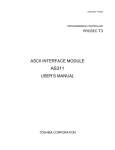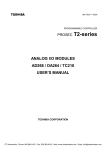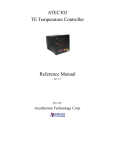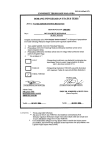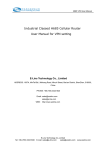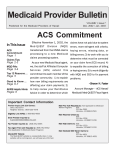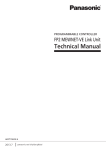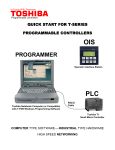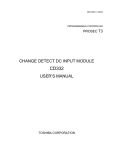Download COMMUNICATION INTERFACE MODULE USER`S MANUAL
Transcript
UM-TS02***-E013 PROGRAMMABLE CONTROLLER PROSEC T2 COMMUNICATION INTERFACE MODULE CF211 USER’S MANUAL TOSHIBA CORPORATION Important Information Misuse of this equipment can result in property damage or human injury. Because controlled system applications vary widely, you should satisfy yourself as to the acceptability of this equipment for your intended purpose. In no event will Toshiba Corporation be responsible or liable for either indirect or consequential damage or injury that may result from the use of this equipment. No patent liability is assumed by Toshiba Corporation with respect to use of information, illustrations, circuits, equipment or examples of application in this publication. Toshiba Corporation reserves the right to make changes and improvements to this publication and/or related products at any time without notice. No obligation shall be incurred other than as noted in this publication. This publication is copyrighted and contains proprietary material. No part of this book may be reproduced, stored in a retrieval system, or transmitted, in any form or by any means ¾ electrical, mechanical, photocopying, recording, or otherwise ¾ without obtaining prior written permission from Toshiba Corporation. Copyright © 1995 by Toshiba Corporation Tokyo, Japan All rights reserved Publication number: UM-TS02***-E013 1st edition June 1995, 2nd edition July 1995 Safety Precautions Safety Precautions · This module (CF211) has been designed for Toshiba’s Programmable Controller PROSEC-T2 (hereafter called T2). Use this module only on the T2’s rack. · Read the Safety Precautions described on the T2 User’s Manual before using the T2 and this module. · Follow the instructions described on this manual and on the T2 User’s Manual when installing and wiring the T2 and this module. · Do not touch the connector pins or components on the printed circuit board of this module. · The maximum number of CF211s that can be controlled by one T2 is limited by internal 5 Vdc power capacity. This module consumes maximum 0.55 A of internal 5 Vdc power. Confirm that the total 5 Vdc consumed current per one power supply module is within the limit (2.5 A). · The CF211 can work with the T2 CPU version 1.2 or later. Confirm that your T2 CPU is correct verson. Symbols Used In This Manual Pay attention to information preceded by the following symbols. HINT NOTE Refers to helpful suggestions on how to operate effectively. Refers to information considered essential for full understanding of operation. And refers to conditions that could damage the equipment or render it temporarily inoperative. User’s Manual 1 About This Manual About This Manual This manual explains the specifications and operations of the Communication Interface module (CF211) for Programmable Controller T2. Read this manual carefully before using the CF211 module. Inside This Manual This manual consists of six sections and an appendix as follows. Section 1 Overview Introduces The CF211. Outline of the function, applications and the external features are provided in this section. Read this section at first to understand the general operation of the CF211. The switch settings of this module are also explained in this section. Section 2 Specifications Provides the functional and the transmission specifications of the CF211. Refer to this section to confirm the application limitations. Section 3 Cable Connections Provides the information for hardware preparations. The transmission cable connection is explained in this section. Section 4 Register Configuration Explains the memory contents of the CF211. This information is important to interchange data between T2 and CF211. Section 5 Operation Procedure Provides the information to design the T2 program for using the CF211. Some sample programs are provided in this section. Read this section carefully for programming. Section 6 RAS Information Provides the helpful information for RAS (Reliability, Availability and Serviceability). Also, lists the check points in case of unexpected operations. Appendix The specifications of READ and WRITE instructions are described. These instructions are used for interchanging data between T2 and CF211. 2 Communicaion Interface Module (CF211) About This Manual Related Manuals The following related manuals are available for T2. Besides this manual, read the following manuals for your better understanding. T2 User’s Manual This manual explains the hardware specifications, installation, wiring and maintenance of the T2 and I/O modules. Also this manual explains the functions of the T2 and how to use them. The necessary information to create user program is covered in this manual. T-series Instruction Set This manual provides the detailed specifications of instructions for Toshiba’s T-series Programmable Controllers. T-PDS (Ver. 1.4) Basic Operation Manual This manual explains how to install the T-series program development system (T-PDS) into your computer and provides basic programming operations. T-PDS (Ver. 1.4) Command Reference Manual This manual explains the T-series program development system (T-PDS) in detail. T-PDS (Ver. 1.6) Expanded Functions This manual explains the expanded functions on the T-PDS version 1.6. This manual supplements the T-PDS (Ver.1.4) Command Reference Manual. Handy Programmer (HP911) Operation Manual This manual explains the functions and the key operations of the T-series Handy Programmer HP911. T-series Computer Link Function This manual provides the information for a computer to communicate with T2 through the T-series Programmable Controller’s Computer Link function. Terminology The following terms and abbreviations are used in this manual. · · · · · ASCII: EIA: I/O: LED: RS-232C: American Standard Code for Information Interchange Electronic Industries Association Input/Output Light Emitting Diode An EIA standard for data transmission User’s Manual 3 Contents Contents 4 Safety Precautions .................................................................................. 1 About This Manual .................................................................................. 2 1. CF211 Overview .......................................................................... 7 1.1 1.2 1.3 Introduction ...................................................................................... CF211 functions ............................................................................... External features .............................................................................. 8 9 10 2. Specifications ............................................................................ 13 2.1 2.2 2.3 General specifications ...................................................................... Functional specifications ................................................................ Transmission specifications ............................................................. 14 14 15 3. Cable Connections ..................................................................... 17 3.1 RS-232C connection ......................................................................... 18 4. Register Configuration .............................................................. 19 4.1 4.2 4.2.1 4.2.2 4.2.3 4.2.4 I/O allocation and I/O registers ........................................................ CF211 buffer memory ........................................................................ Memory map ............................................................................... Buffer memory access ................................................................ Parameter area ............................................................................ Receiving and transmitting data area .......................................... 20 22 22 23 25 30 5. Operation Procedure ................................................................. 31 5.1 5.2 5.2.1 5.2.2 5.3 5.3.1 5.3.2 5.4 5.5 5.6 5.7 Transmission message format .......................................................... Received message read sequence .................................................. Flag control timing ....................................................................... T2 sample program for message receiving ................................... Write sequence for message transmitting ....................................... Flag control timing ....................................................................... T2 sample program for message transmitting ................................ Checking the CF211 operation status .............................................. Resetting the CF211 by software ...................................................... Setting the trailing code .................................................................... Setting the time-out check time ........................................................ 32 33 33 34 37 37 38 41 42 43 44 Communicaion Interface Module (CF211) Contents 6. RAS Information ......................................................................... 45 6.1 6.2 6.2.1 6.2.2 6.2.3 6.2.4 6.3 LED indication .................................................................................. Buffer memory information ................................................................ Module status .............................................................................. Switch setting status ................................................................... Error information for data receiving .............................................. Error information for data transmitting .......................................... Trouble shooting ............................................................................... 46 47 47 48 49 50 51 Appendix A.1 A.2 .................................................................................................... 53 Specification of the READ instruction ............................................... Specification of the WRITE instruction ............................................ 54 56 User’s Manual 5 6 Communicaion Interface Module (CF211) Section 1 CF211 Overview 1.1 Introduction 1.2 CF211 functions 1.3 External features User’s Manual 7 1. CF211 Overview 1.1 Introduction PROSEC- The Communication Interface module CF211 (hereafter called CF211) is a general purpose data communication module for Toshiba’s Programmable Controller T2 (hereafter called T2). By using the CF211, T2 can communicate with external devices, such as a micro computer, bar code reader, printer, display device, sensor, etc., through the serial interface RS-232C. The CF211 has one port of RS-232C serial interface. The transmission is asynchronous (start-stop system). ASCII is used as the transmission data code. The figure below shows the typical system configuration. T2 CF211 RS-232C CPU module The maximum number of CF211s that can be controlled by one T2 is limited by internal 5 Vdc power capacity. The CF211 consumes maximum 0.55 A of internal 5 Vdc power. Confirm that the total 5 Vdc consumed current per one power supply module is within the limit (2.5 A). NOTE 8 Communicaion Interface Module (CF211) 1. CF211 Overview 1.2 CF211 functions From the point of view of T2, the CF211 works as communications driver. The followings are the simplified explanations for T2 and CF211 functions. When a message (one set of transmission characters) is received by CF211, the flag which indicates the receiving complete will come ON. T2 can check the flag status then read the message from the CF211 by using the READ instruction. In case of transmitting a message (one set of transmission characters) from T2 through CF211, T2 writes the message into the CF211 by using the WRITE instruction, then sets the flag which instruct the CF211 to start transmitting the message. T2 CF211 Register Buffer memory READ WRITE Receiving area Transmitting area Receiving buffer Channel 1 Transmitting buffer Here, a message (one set of transmission characters) means a string of ASCII characters which is ended by specified trailing code. The default setting of the trailing code is CR (carriage return code = H0D). Applicable message format (default trailing code): 1 2 3 4 N-1 N CR N: message length = 320 bytes max. In other words, the CF211 cannot be used for the data communication in which the transmission message is ended by two or more types of trailing code. User’s Manual 9 1. CF211 Overview 1.3 External features Status LED CF211 RESET CH1 8 7 6 5 4 3 2 1 Hardware reset switch Transmission parameter setting switches ON ® Channel 1 serial port (RS-232C) D-Sub 9-pin female connector CH1 CIF 10 Communicaion Interface Module (CF211) 1. CF211 Overview Status LED Indicates the transmission status. CH1 Lit while transmitting or receiving data through channel 1 Transmission parameter setting switches Used to set the transmission parameters. 8 Baud rate (see table below) 7 6 5 4 No.5 Stop bit OFF 2 bit ON 1 bit No.4 Data bit length OFF 7 bit ON 8 bit 3 2 1 ON ® OFF OFF/ON None No.3 No.2 Parity ON OFF Even ON ON Odd No use Baud rate No.8 No.7 No.6 Baud rate NOTE OFF OFF OFF 300 OFF OFF ON 600 OFF ON OFF 1200 OFF ON ON 2400 ON OFF OFF 4800 ON ON OFF ON ON OFF 9600 19200 (1) When stop bit is set as 2 bits, the data bit length must be 7 bits. (2) When none parity is used, the data bit length must be 8 bits. (3) The factory settings are all OFF. Set these switches as required before using this module. (4) The switch setting status is recognized at module initialization by turning power on, pressing the hardware reset switch or issuing the software reset command (cold reset). User’s Manual 11 1. CF211 Overview Hardware reset switch When this switch is pressed, the CF211 will be reset. Use this switch when you have changed the switch settings. Channel 1 serial port Used to connect the serial transmission line (RS-232C). D-Sub 9-pin female connector is provided on the CF211. The pin assignment is as follows. Channel 1 (RS-232C) 1 2 3 4 5 6 7 8 9 · · · · 12 RXD TXD DTR SG DSR 5 Vdc ¬ ® ® « ¬ ® The arrow on the above figure shows the signal direction. DTR is ON while power is on. DSR has no effect for transmission. Pin 7 (5 Vdc) can be used to supply 5 Vdc power to external devices. (max. 50 mA) Communicaion Interface Module (CF211) Section 2 Specifications 2.1 General specifications 2.2 Functional specifications 2.3 Transmission specifications User’s Manual 13 2. Specifications 2.1 General specifications Item Power voltage Current consumption Environmental conditions Insulation Size Weight Specifications 5 Vdc (supplied from back plane bus) 0.55 A (5 Vdc) maximum Conforms to T2 specifications None T2 I/O module size (1 slot) 250 g Remarks Note (1) Note (2) Note (1) The T2’s power supply module can supply maximum 2.5 A of internal 5 Vdc. Check that the internal 5 Vdc current consumption per one power supply module does not exceed the limit. Note (2) Between interface connector pins and internal circuit. 2.2 Functional specifications Item Module type I/O allocation type Buffer memory capacity Transmission interface Display Connectable devices RAS function 14 Specifications Serial communication interface iX+Y 4W 160 words x 2 (accessed from T2 by READ/WRITE instruction) RS-232C, 1 channel Transmission status LED; CH1 ¼ lit while transmitting or receiving data through the transmission port. Computer, bar code reader, display device, sensor, printer, or other serial ASCII device Self diagnosis, watch dog timer, transmission error check, etc. Communication Interface Module (CF211) 2. Specifications 2.3 Transmission specifications Item Interface Transmission mode Synchronizing Transmission speed Frame format Transmission code Message length Configuration Transmission distance Connector Specifications Conforms to RS-232C Full-duplex Start-stop method (asynchronous) 300, 600, 1200, 2400, 4800, 9600, 19200 bps 1 bit Start bit 7 or 8 bits Data even / odd / none Parity 1 or 2 bits (Note) Stop bit ASCII Max. 320 bytes One to one Max. 15 m D-sub 9-pin female Note) When none parity is selected, the data bit length must be 8 bits. When stop bit is selected as 2 bits, the data bit length must be 7 bits. User’s Manual 15 16 Communication Interface Module (CF211) Section 3 Cable Connections 3.1 RS-232C connection User’s Manual 17 3. Cable Connections 3.1 RS-232C connection The following figure shows the RS-232C connection. CF211 1 2 3 4 5 6 7 8 9 Shielded cable RXD TXD DTR SG DSR 5 Vdc RS-232C device TXD RXD DTR SG DSR RTS CTS (1) Allowable maximum cable length is 15 m. (2) Use shielded cable. The cable shield should be connected to grounding point at one end. (3) It is recommended to use twisted cable for noise immunity. (4) DTR is ON while power is on. (5) DSR has no effect for transmission. (monitor only) (6) Connect SG each other. (7) RTS and CTS signals are not supported by the CF211. If necessary, short these signals at the connected device end. NOTE 18 Do not connect or remove the connector while the CF211 is powered. Otherwise, it will cause damage to the CF211. Communication Interface Module (CF211) Section 4 Register Configuration 4.1 I/O allocation and I/O registers 4.2 CF211 buffer memory User’s Manual 19 4. Register Configuration 4.1 I/O allocation and I/O registers The CF211 should be allocated as ‘i X+Y 4W’ for I/O allocation. However, when the automatic I/O allocation is performed with mounting the CF211, the CF211 is allocated as ‘X+Y 4W’. You should change the allocation to ‘i X+Y 4W’ by using the manual I/O allocation function. (T-PDS screen example - in the case that CF211 is mounted on Slot 0 of Unit 0) When the automatic I/O allocation is performed. Change the allocation to ‘i X+Y 4W’ by using the manual I/O allocation. Then, 4 I/O registers, XW(n), XW(n+1), YW(n+2) and YW(n+3), are assigned to the CF211. In the above example, XW000, XW001, YW002 and YW003 are assigned. Note that the I/O type has ‘i’ designation. It means that the T2 will not update the assigned I/O registers in the batch I/O processing. To read or write data through the I/O registers, the Direct I/O instruction (FUN235) or the direct I/O designation (I/IW and O/OW instead of X/XW and Y/YW) is necessary. The reason of that is because the reading and writing timings are important for handshaking between T2 and CF211. Refer to section 5. 20 Communication Interface Module (CF211) 4. Register Configuration The following table shows the functions of I/O registers assigned to the CF211. F XW(n) XW(n+1) YW(n+2) YW(n+3) Register E D C No use A 9 8 7 6 5 4 3 No use No use (reserved) No use No use (reserved) Name Write ready Transmit complete Transmit error XW(n) (Status) Read ready Receive complete Receive error XW(n+1) F Transmit start YW(n+2) E-C (Command) B Read start A-0 YW(n+3) - NOTE Bit F E D C B A 9 8-0 B 2 1 0 Status Command Description 1: ready to write data (transmit) 1: transmitting has been completed normally 1: transmitting has been canceled by error No use (always 0) 1: ready to read the received data 1: receiving has been completed 1: receiving error has occurred No use (always 0) No use (always 0) Set to 1 to start transmitting No use (set to 0) Set to 1 to start reading No use (set to 0) No use (set to 0) These bits are used for handshaking between T2 and CF211. The detailed function and timing are explained in section 5. User’s Manual 21 4. Register Configuration 4.2 CF211 buffer memory As explained in the previous section, the I/O registers that are assigned to CF211 are used to control the reading and writing timings (handshake) between T2 and CF211. On the other hand, for exchanging the transmission data between T2 and CF211, the CF211’s buffer memory is used. This section explains the buffer memory contents and how to access the buffer memory. 4.2.1 Memory map The CF211 has the buffer memory that is used to exchange data with T2. The overall map of the buffer memory is as follows. Address H8000 Word data Parameter 16 words - transmission parameters, etc. H800F H8010 Reading (receiving) data area 160 words Writing (transmitting) data area 160 words H80AF H80B0 H814F 22 Communication Interface Module (CF211) 4. Register Configuration 4.2.2 Buffer memory access T2 can read the CF211’s buffer memory contents by using READ instruction (FUN237). Also, T2 can write data into the buffer memory by using WRITE instruction (FUN238). READ instruction (FUN237) Expression: ¾[ (A) READ (B) ® (C) ]¾ Operands: (A): (B): (B)+1: (C): I/O register (XW/YW) assigned to the CF211 Starting address of the buffer memory to be read. Number of words to be read (max. 160 for CF211) Starting register of the destination Example: R0100 [ H8010 MOV D3000 ] [ 00064 MOV D3001 ] [ XW000 READ D3000 ® D1000 ] When R0100 is ON, 64 words of buffer memory data starting with address H8010 are read from the CF211 which is allocated to XW000. And the data are stored in D1000 and after. User’s Manual 23 4. Register Configuration WRITE instruction (FUN238) Expression: ¾[ (A) WRITE (B) ® (C) ]¾ Operands: (A): (B): (B)+1: (C): Starting register of the source Starting address of the buffer memory to be written Number of words to be written (max. 160 for CF211) I/O register (XW/YW) assigned to the CF211 Example: R0101 [ H80B0 MOV D3010 ] [ 00100 MOV D3011 ] [ D2000 WRITE D3010 ® YW002 ] When R0101 is ON, 100 words of data starting with D2000 (D2000 to D2099) are written into the buffer memory address H80B0 and after of the CF211 which is allocated to YW002. 24 Communication Interface Module (CF211) 4. Register Configuration 4.2.3 Parameter area The parameter area of the buffer memory contains the following contents. Address H8000 01 02 03 04 05 06 07 08 09 0A 0B 0C 0D 0E 0F Word data Status 1 Switch setting status Command 1 Receive error information Transmit error information Channel status Receive length Trailing code Time-out check time Note: Blanks are for future use. (Reserved) User’s Manual 25 4. Register Configuration Status 1 (H8000) The address H8000 shows the CF211 module status. If an error has occurred in the CF211, the error code is stored here. F H8000 E RDY ERR D C B A 9 8 0 0 0 0 0 0 Bit F RDY (Ready) Bit E ERR (Error) Bit 7-0 Error code 7 6 5 4 3 2 1 0 Error code 1 = operating normally 0 = under initialization or error state 1 = error state 0 = no error (normal) Shows the detected error item if ERR is 1. (H00 when normal) See section 6.2.1 for details. Switch setting status (H8002) The address H8002 stores the setting status of the transmission parameter setting switches. H8002 F E D C B A 9 8 0 0 0 0 0 0 0 0 OFF ON 8 7 6 5 4 3 2 1 ON: 1 26 Communication Interface Module (CF211) OFF: 0 7 6 5 4 3 Switch setting status 2 1 0 0 4. Register Configuration Command 1 (H8005) The address H8005 is used to reset the CF211 by T2 program. Two types of reset commands are available, hot reset and cold reset. The hot reset is used to change the trailing code and the time-out check time settings. The cold reset is used to initialize the CF211. The trailing code and the time-out check time will be reset to the default setting. The operation of the cold reset is the same as the hardware reset switch and power on initialization. Refer to sections 5.5, 5.6 and 5.7 for these functions. H8005 F E D C B A 9 8 RST 0 0 0 0 0 0 0 Bit F RST (Reset) Bit 7-0 Command number 7 6 5 4 3 2 1 0 1 0 Command number 1 = reset request 0 = normal (no reset request) HFE = hot reset HFF = cold reset Receive error information (H8007) The address H8007 indicates the error contents if an error has been detected in receiving a message. This information is set during the received message read sequence. Refer to section 6.2.3 for details. H8007 F E D C B A 9 8 0 0 0 0 0 PE 0 0 Bit A PE (Parity error) Bit 7-0 Receive error code 7 6 5 4 3 2 Receive error code 1 = parity error 0 = normal Shows the error code regarding received message. (H00 when normal) See section 6.2.3 for details. User’s Manual 27 4. Register Configuration Transmit error information (H8008) The address H8008 indicates the error contents if an error has occurred during message transmitting. This information is set during the write sequence for message transmitting. Refer to section 6.2.4 for details. H8008 F E D C B A 9 8 0 0 0 0 0 0 0 0 Bit 7-0 Transmit error code 7 6 5 4 3 2 1 0 Transmit error code Shows the error code for transmitting. (H00 when normal) See section 6.2.4 for details. Channel status (H8009) The address H8009 indicates the control signal status. This information is always updated. H8009 F E D C B A 9 8 7 6 5 4 3 2 1 0 0 0 0 0 0 0 0 0 DSR 0 0 0 0 0 0 0 Bit 7 DSR (Data set ready) 1 = DSR is ON 0 = DSR is OFF Receive length (H800A) The address H800A indicates the length of the received message (number of bytes). This information is set during the received message read sequence. F E D C B A H800A Bit F-0 28 9 8 7 6 5 4 3 2 Received message length Received message length Shows the received message length (bytes). 0 - 320 Communication Interface Module (CF211) 1 0 4. Register Configuration Trailing code (H800C) The address H800C stores the trailing codes. The default setting is H0D (CR code). To change the trailing code, write the desired code into this address then write the hot reset command into the Command 1 (H8005). See section 5.6 for this procedure. H800C F E D C B A 9 8 0 0 0 0 0 0 0 0 Bit 7-0 Trailing code 7 6 5 4 3 2 1 0 Trailing code Stores the trailing code. Initial value at power on is H0D (carriage return). Time-out check time (H800D) The address H800D stores the time-out check time. If the time between each transmitting or receiving character exceeds the specified time-out check time, it becomes the time-out error. The default setting is 1 second. To change the setting, write the desired data into this address then write the hot reset command into the Command 1 (H8005). See section 5.7 for this procedure. F E D C B 9 8 7 6 5 4 3 2 1 0 Time-out check time H800D Bit F-0 A Time-out check time Stores the time-out check time (0.1 s units). Valid data range is 1 to 600 (0.1 to 60 s). If 0 or more than 600 is specified, the time-out check will not work. Initial value at power on is 10 (1 s). User’s Manual 29 4. Register Configuration 4.2.4 Receiving and transmitting data area The receiving and transmitting data area is provided to exchange the communication characters between T2 and CF211. The address ranges in the CF211 buffer memory are as follows. Address H8010 Word data Reading (receiving) data area 160 words Writing (transmitting) data area 160 words H80AF H80B0 H814F When CF211 receives a message (one set of transmission characters), CF211 sets the characters into the receiving data area starting with the address H8010. Then T2 can read these characters from the receiving data area by using READ instruction. When T2 attempts to send a message via CF211, T2 writes the characters into the transmitting data area starting with the address H80B0 by using WRITE instruction, and instructs CF211 to start transmitting. CF211 recognizes from the character stored in the starting address (H80B0) to the trailing code character as the one set of transmitting message. Refer to section 5 for message receiving/transmitting procedure. 30 Communication Interface Module (CF211) Section 5 Operation Procedure 5.1 5.2 5.3 5.4 5.5 5.6 5.7 Transmission message format Received message read sequence Write sequence for message transmitting Checking the CF211 operation status Resetting the CF211 by software Setting the trailing code Setting the time-out check time User’s Manual 31 5. Operation Procedure 5.1 Transmission message format The transmission message is composed by ASCII characters and a specified trailing code. The default setting of the trailing code is CR (carriage return code = H0D). Refer to section 5.6 for setting the trailing code other than CR. The maximum length of a message is 320 bytes. An example of the message is shown below. 1 2 3 4 5 6 7 8 9 ²0² ²1² ²2² ²A² ²B² ²7² ²8² ²9² CR In the above figure, ²x² means an ASCII character. For example, ²0² is H30. When the above message is received or transmitted, the data arrangements in the T2 registers are as follows. Register n n+1 n+2 n+3 n+4 32 F 8 7 ²1² ²A² ²7² ²9² 0 ²0² ²2² ²B² ²8² CR Communication Interface Module (CF211) Transmission message ²0² ²1² ²2² ²A² ²B² ²7² ²8² ²9² CR 5. Operation Procedure 5.2 Received message read sequence 5.2.1 Flag control timing In case of receiving a message, the following flags are used for handshaking between T2 and CF211. These flags are the bits of the I/O registers assigned to the CF211. Refer to section 4.1. Read ready Receive complete Receive error Bit B of XW(n) Bit A of XW(n) Bit 9 of XW(n) Read start Bit B of YW(n+2) The message receiving procedure is as follows. It is called “received message read sequence”. CF211 receives a message CF211 sets Receive complete to ON T2 sets Read start to ON Normal receiving Receiving error CF211 sets the message into buffer memory (receiving data area), and sets the received message length into buffer memory (parameter area) CF211 sets the error information into buffer memory (parameter area) CF211 sets Read ready to ON, and resets Receive complete to OFF CF211 sets Receive error to ON, and resets Receive complete to OFF T2 reads the message form buffer memory (receiving data area) by READ instruction T2 reads the error information from buffer memory (parameter area) by READ instruction T2 resets Read start to OFF T2 resets Read start to OFF CF211 resets Read ready to OFF CF211 resets Receive error to OFF User’s Manual 33 5. Operation Procedure 5.2.2 T2 sample program for message receiving A sample program for the “received message read sequence” is shown below. This sample program is for the CF211 that is allocated to XW000 - YW003. (Main program) Operation for normal received message Operation for receiving error (Subroutine No. 0) (H8010) (H8007) 34 Communication Interface Module (CF211) 5. Operation Procedure In this sample program, the following devices/registers are used. R0100 R0200 R0300 CF211 status (ON when ready) - Refer to section 5.4 Receiving normal complete (comes ON when receiving is complete normally) Receiving error complete (comes ON when receiving error has occurred) X000A X000B X0009 Y002B Receive complete flag Read ready flag Receive error flag Read start flag D0000 - D0063 D3000 D4000 - D4001 Received message is stored here Receiving error information is stored here Parameters for READ instruction This sample program works as follows. Main program - Rung 1: Calls Subroutine No. 0 when the CF211 is normal and both R0200 and R0300 are OFF. - Rung 2: When R0200 comes ON (normal receiving), performs the necessary operation for the received message, then resets R0200 to OFF. - Rung 3: When R0300 comes ON (receiving error has occurred), performs the error processing, then resets R0300 to OFF. Subroutine No. 0 - Rung 1: Indicates the entry of Subroutine No. 0. - Rung 2: Reads XW000 and XW001 from the CF211 by direct I/O instruction. - Rung 3: Sets Y002B (Read start flag) to ON if X000A (Receive complete flag) is ON. - Rung 4: When X000B (Read ready flag) comes ON, reads the received message from the CF211’s buffer memory, 64 words starting with address H8010, by READ instruction, and stores it into D0000 and after. Then resets Y002B (Read start flag) to OFF, and sets R0200 to ON. When X0009 (Receive error flag) comes ON, reads the error information from the CF211’s buffer memory, 1 word of address H8007, by READ instruction, and stores it into D3000. Then resets Y002B (Read start flag) to OFF, and sets R0300 to ON. - Rung 5: Writes YW002 and YW003 into the CF211 by direct I/O instruction. - Rung 6: Indicates the return of Subroutine No. 0. User’s Manual 35 5. Operation Procedure Explanation for this sample program: (1) The “received message read sequence” is programmed on Subroutine No. 0. (2) The Subroutine No. 0 is called from Main program with resetting R0200 and R0300 to OFF. (3) When a message is received normally, R0200 will come ON and the message (ASCII characters) will be stored in D0000 to D0063. In this sample program, the received message length information (buffer memory address H800A) is not used. The maximum length of a message is 128 bytes (64 words) because the number of read words of the READ instruction is programmed as 64 words. (4) When an error has occurred in receiving the message, R0300 will come ON and the error information will be stored in D3000. For details of the error information, refer to section 6.2.3. 36 Communication Interface Module (CF211) 5. Operation Procedure 5.3 Write sequence for message transmitting 5.3.1 Flag control timing In case of transmitting a message, the following flags are used for handshaking between T2 and CF211. These flags are the bits of the I/O registers assigned to the CF211. Refer to section 4.1. Write ready Transmit complete Transmit error Bit F of XW(n) Bit E of XW(n) Bit D of XW(n) Transmit start Bit F of YW(n+2) The message transmitting procedure is as follows. It is called “write sequence for message transmitting”. T2 checks Write ready is ON T2 writes a message into buffer memory (transmitting data area) by WRITE instruction T2 sets Transmit start to ON CF211 resets Write ready to OFF Normal transmitting CF211 sends out the message and sets Transmit complete to ON Transmitting error CF211 sets the error information into buffer memory (parameter area) and sets Transmit error to ON T2 resets Transmit start to OFF CF211 resets Transmit complete to OFF, and sets Write ready to ON T2 reads the error information from buffer memory (parameter area) by READ instruction, and resets Transmit start to OFF CF211 resets Transmit error to OFF, and sets Write ready to ON User’s Manual 37 5. Operation Procedure 5.3.2 T2 sample program for message transmitting A sample program for the “write sequence for message transmitting” is shown below. This sample program is for the channel 1 of the CF211 that is allocated to XW000 YW003. (Main program) Set the transmission message into D0200 - D0263, and set R0110 to ON Operation for transmitting error (Subroutine No. 1) (H80B0) (H8008) 38 Communication Interface Module (CF211) 5. Operation Procedure In this sample program, the following devices/registers are used. R0100 R0110 R0201 R0301 X000F X000E X000D Y002F CF211 status (ON when ready) - Refer to section 5.4 Internal flag to start transmitting Transmitting normal complete (comes ON when transmitting is complete normally) Transmitting error complete (comes ON when transmitting error has occurred) Write ready flag Transmit complete flag Transmit error flag Transmit start flag D0200 - D0263 D3010 D4010 - D4011 D4000 - D4001 Transmitting message is set here Transmitting error information is stored here Parameters for WRITE instruction Parameters for READ instruction This sample program works as follows. Main program - Rung 1: Prepares a transmission message and sets it into D0200 and after (maximum 64 words in this sample). Then sets R0110 to ON. - Rung 2: Calls Subroutine No. 1 when the CF211 is normal and R0110 is ON. - Rung 3: When R0201 comes ON (normal transmitting), resets R0110 and R0201 to OFF. - Rung 4: When R0301 comes ON (transmitting error has occurred), performs the error processing, then resets R0110 and R0301 to OFF. Subroutine No. 1 - Rung 1: Indicates the entry of Subroutine No. 1. - Rung 2: Reads XW000 and XW001 from the CF211 by direct I/O instruction. - Rung 3: When X000F (Write ready flag) is ON, writes the message that is stored in D0200 to D0263 into the CF211’s buffer memory, 64 words starting with address H80B0, by WRITE instruction, and sets Y002F (Transmit start flag) to ON. - Rung 4: When X000E (Transmit complete flag) comes ON, resets Y002F (Transmit start flag) to OFF, and sets R0201 to ON. When X000D (Transmit error flag) comes ON, reads the error information from the CF211’s buffer memory, 1 word of address H8008, by READ instruction, and stores it into D3010. Then resets Y002F (Transmit start flag) to OFF, and sets R0301 to ON. - Rung 5: Writes YW002 and YW003 into the CF211 by direct I/O instruction. - Rung 6: Indicates the return of Subroutine No. 1. User’s Manual 39 5. Operation Procedure Explanation for this sample program: (1) The “write sequence for message transmitting” is programmed on Subroutine No. 1. (2) To start transmitting, set the message (ASCII characters) into D0200 and after. Then set R0110 to ON. The message length is maximum 128 bytes (64 words) in this sample program. (3) When R0110 is set to ON while the CF211 is ready, the Subroutine No. 1 will be called and the message transmitting will be started. (4) When the message is transmitted normally, R0201 will come ON. Then R0110 will be reset to OFF. (5) When an error has occurred in transmitting the message, R0301 will come ON and the error information will be stored in D3010. For details of the error information, refer to section 6.2.4. 40 Communication Interface Module (CF211) 5. Operation Procedure 5.4 Checking the CF211 operation status CF211 operation status information is stored in the CF211’s buffer memory address H8000 (Status 1). T2 can read this information by using READ instruction. A sample program is shown below. This sample program is for the CF211 that is allocated to XW000 - YW003. (H8000) The above sample program works as follows. - Rung 1: Resets S0051 (Instruction error flag) to OFF, and sets parameters for the READ instruction. - Rung 2: Reads the operation status information from the CF211’s buffer memory address H8000 (Status 1). - Rung 3: When S0051 (Instruction error flag) is OFF and R050F (Ready) is ON, turns R0100 to ON. It means that the CF211 is operating normally when R0100 is ON. If R050E (Error) is ON, the CF211 is in error state. In that case, the error code is stored in the lower 8 bits of RW050. For the error code, refer to section 6.2.1. If S0051 (Instruction error flag) is ON, it means that an error has occurred during the READ instruction execution. User’s Manual 41 5. Operation Procedure 5.5 Resetting the CF211 by software CF211 can be reset by T2 program. Two types of resetting are available, cold reset and hot reset. The cold reset is used to reset the CF211 error state. When the cold reset is executed, the CF211 will be initialized. The trailing code and the time-out check time are also reset to the default settings. This function is the same as pressing the hardware reset switch and power on initialization. On the other hand, the hot reset is used to change the trailing code and/or the time-out check time. For executing these functions, write the following data into the CF211’s buffer memory address H8005 (Command 1). The data writing into this address must be one-shot. Clod reset: H80FF Hot reset: H80FE The written data will be cleared to 0 by CF211 when the operation is completed. A sample program for the cold reset is shown below. This sample program is for the CF211 that is allocated to XW000 - YW003. In this sample program, the cold reset operation will be started by setting R0120 to ON. (Main program) (Subroutine No. 2) (H80FF) (H8005) For the hot reset, refer to sections 5.6 and 5.7. 42 Communication Interface Module (CF211) 5. Operation Procedure 5.6 Setting the trailing code The default setting of the trailing code is CR (carriage return code = H0D). The trailing code can be changed by T2 program. To do this, write desired trailing code into the CF211’s buffer memory address H800C (Trailing code), and execute the hot reset (refer to section 5.5). A sample program is shown below. This sample program is for the CF211 that is allocated to XW000 - YW003. In this sample program, the trailing code changing routine will be executed once when the CF211 status is changed to ready (R0100 comes ON - refer to section 5.4), and the trailing code will be changed to H03. If the time-out check time are also changed, write these data on the Main program Rung 2 before calling Subroutine No. 3 in the same manner. (Main program) (H0003) (H800C) (Subroutine No. 3) (H80FE) (H8005) (H8005) User’s Manual 43 5. Operation Procedure 5.7 Setting the time-out check time The default setting of the time-out check time is 1 second. The time-out check time can be changed by T2 program. The valid setting range is 0.1 to 60.0 seconds in 0.1 second units. Refer to section 4.2.3. To change the time-out check time, write desired value into the CF211’s buffer memory address H800D (Time-out check time), and execute the hot reset (refer to section 5.5). T2 program for this purpose is almost same as that for setting the trailing code (refer to section 5.6). Only the difference is writing the time-out check time instead of the trailing code. See Rung 2 of the following sample. In this sample, the time-out check time is changed to 5 seconds. If the trailing code are also changed, write these data on the Main program Rung 2 before calling Subroutine No. 3 in the same manner. (Main program) (H800D) 44 Communication Interface Module (CF211) Section 6 RAS Information 6.1 LED indication 6.2 Buffer memory information 6.3 Trouble shooting User’s Manual 45 6. RAS Information 6.1 LED indication On the CF211, a status LED is provided as follows. This LED is useful to check the CF211 communication status. CH1 46 CH1 Indicates the serial port communication status. Lit while some data is transmitting from or receiving into the CF211. Communication Interface Module (CF211) 6. RAS Information 6.2 Buffer memory information Useful RAS information is stored in the CF211’s buffer memory. The information can be read by READ instruction. When your CF211 does not work as expected, check the RAS information. 6.2.1 Module status Address H8000 of the buffer memory stores the CF211 module status. F H8000 E RDY ERR D C B A 9 8 0 0 0 0 0 0 Bit F RDY (Ready) Bit E ERR (Error) Bit 7-0 Error code Error code H01 CPU error H02 ROM error H03 RAM error H04 Buffer memory error Switch setting illegal Watchdog timer error H05 H10 Type of error 7 6 5 4 3 2 1 0 Error code 1 = operating normally 0 = under initialization or error state 1 = error state 0 = no error (normal) Shows the detected error item if ERR is 1. See the table below (H00 when normal) Description CPU error has been detected during initialization. ROM error has been detected during initialization. Work RAM error has been detected during initialization. Buffer memory error has been detected during initialization. Illegal switch setting has been detected during initialization. Watchdog timer error has occurred during operation. Status Operation is stopped. Operation is stopped. Operation is stopped. Operation is stopped. Operation is stopped. Operation is stopped. Cold reset will be effective. User’s Manual 47 6. RAS Information 6.2.2 Switch setting status Addresses H8002 of the buffer memory store the switch setting status. Check that the information agrees with the physical setting status if CF211 does not work as expected. H8002 F E D C B A 9 8 0 0 0 0 0 0 0 0 OFF ON 8 7 6 5 4 3 2 1 ON: 1 48 Communication Interface Module (CF211) OFF: 0 7 6 5 4 3 Switch setting status 2 1 0 0 6. RAS Information 6.2.3 Error information for data receiving Address H8007 stores the error information for data receiving. H8007 F E D C B A 9 8 0 0 0 0 0 PE 0 0 Bit A PE (Parity error) Bit 7-0 Receive error code Error code H01 Type of error Receive timeout error H02 Message length error H03 Receive buffer overflow 7 6 5 4 3 2 1 0 Receive error code 1 = parity error 0 = normal When parity error has occurred in a receiving message, the entire message is disabled. The next message can be received. Shows the error code regarding received message. See the table below. (H00 when normal) Description Status Specified time-out check time has elapsed between characters. The message length has exceeded the limit. (320 bytes) Receive buffer overflow has occurred. The rest of the message will be received as the next message. The message is disabled. The next message can be received. The message is disabled. The next message can be received. NOTE When T2 is in HALT mode, the T2 cannot read any received message from the CF211. Therefore, if CF211 has received some messages while the T2 is in HALT mode, the receive buffer overflow may occur when the T2 is changed to RUN mode. User’s Manual 49 6. RAS Information 6.2.4 Error information for data transmitting Address H8008 stores the error information for data transmitting. H8008 F E D C B A 9 8 0 0 0 0 0 0 0 0 Bit 7-0 Error code H01 H02 50 Transmit error code 7 6 4 3 2 1 Transmit error code Shows the error code for transmitting. See the table below. (H00 when normal) Type of error Description Transmit timeout error Specified time-out check time has elapsed between characters. The trailing code has not been written into the buffer memory. Trailing code missing 5 Communication Interface Module (CF211) Status The next message can be transmitted. The message is disabled. The next message can be transmitted. 0 6. RAS Information 6.3 Trouble shooting When CF211 does not work properly, check the following points. When T2 cannot run properly; Does the POWER LED on the T2 power supply module light ? If no, check the power voltage/connection. If no, check the internal 5 Vdc current consumption. Is the CF211 mounted securely on the base ? Remove the CF211, and mount again securely. When CH1 LED does not light while the connected device is transmitting a message; Are the transmission signals (RXD, SG, etc.) connected properly ? Check the cable connection. When the received data cannot be read properly; Does the receive error occur ? Check the transmission parameters (baudrate, parity, etc.). Check the cable connection. Confirm the receive error information. When a data cannot be transmitted from the CF211 (CH1 LED does not light); Is the T2 program working correctly ? Check the T2 program. Does the transmit error occur ? Confirm the transmit error information. Check the T2 program. User’s Manual 51 52 Communication Interface Module (CF211) Appendix A.1 Specification of the READ instruction A.2 Specification of the WRITE instruction User’s Manual 53 Appendix A.1 Specification of the READ instruction FUN 237 Special module data read (READ) Reads designated range of data from the special module. Input Execution output [ A READ B ® C ] Function · This instruction reads data from the buffer memory of the special module that is designated by operand A, and stores them in T2’s registers starting with operand C. · The transfer source address (buffer memory Input Action Output address) is designated by operand B. OFF No execution OFF · The transfer size (number of words) is ON Normal execution ON designated by operand B+1. Error (see Note 2) ON ERF ON Index Operand Constant Device X Opr Name A Special module B Transfer parameter C Top register of destination Y S L R Z Register T. C. I O XW YW SW LW RW W T C D F IW OW I Ö Ö J K Ö Ö Ö Ö Ö Ö Ö Ö Ö Ö Ö Ö Ö Ö Ö Ö Ö Ö Ö Ö Ö Ö Program example R0000 [ XW000 READ RW010 ® D0100 ] · When R0000 is ON, the buffer memory data of the size indicated by RW011, starting with the address indicated by RW010 of the special module allocated to XW000, are read and stored in D0100 and after. · The maximum number of words to be read is 160 words. (For CF211) XW000 special module T2 RW010 H8000 RW011 16 Buffer memory 54 H8000 1234 READ D0100 1234 H800F 5678 16 words D0115 5678 Communication Interface Module (CF211) Appendix Note 1) The special module can be designated not only by the assigned register, but also by the mounting position. The mounting position is designated by a constant data for the operand A as follows. (Unit number) ´ 256 + (Slot number) H Slot number (hexadecimal) Unit number (hexadecimal) Unit number 0 1 2 3 Hexadecimal H00 H01 H02 H03 Slot number 0 1 2 3 4 5 6 7 Hexadecimal H00 H01 H02 H03 H04 H05 H06 H07 For example, if a special module is mounted on Slot-4, Unit-0 (basic unit) and allocated to XW008 - YW011, the following two READ instructions function the same. [ XW008 READ RW010 ® D0100 ] [ H0004 READ RW010 ® D0100 ] Note 2) The READ instruction is not executed as error in the following cases. In these cases, ERF (instruction error flag = S0051) is set to ON. If the ERF is set to ON once, it remains ON until resetting to OFF by user program. · When the operand A is other than a valid constant (see Note 1) or XW/YW register. · When no answer error occurs with the designated special module. · When the number of words transferred exceeds 256 words. · When the source table of transfer is out of the valid range. · When the destination table of transfer is out of the valid range. User’s Manual 55 Appendix A.2 Specification of the WRITE instruction FUN 238 Special module data write (WRITE) Writes designated range of data into the special module. Input Execution output [ A WRITE B ® C ] Function · This instruction transfers data stored in T2’s registers starting with operand A into the buffer memory of the special module that is designated by operand C. · The destination address (buffer memory Input Action Output ERF address) is designated by operand B. OFF No execution OFF · The transfer size (number of words) is ON Normal execution ON designated by operand B+1. Error (see Note 2) ON ON Index Operand Constant Device Opr Name A Top register of source B Transfer parameter C Special module X Y S L R Z Register T. C. I O XW YW SW LW RW W T C D F IW OW I Ö Ö Ö Ö Ö Ö Ö Ö Ö Ö J K Ö Ö Ö Ö Ö Ö Ö Ö Ö Ö Ö Ö Ö Ö Ö Program example R0000 [ D0100 WRITE RW010 ® YW002 ] · When R0000 is ON, the register data of the size indicated by RW011, starting with D0100, are transferred to the buffer memory starting with the address indicated by RW010 of the special module allocated to YW002. · The maximum number of words to be transferred is 160 words. (For CF211) T2 YW002 special module RW010 H80B0 RW011 150 56 Buffer memory D0100 1234 WRITE H80B0 1234 D0249 5678 150 words H8145 5678 Communication Interface Module (CF211) Appendix Note 1) The special module can be designated not only by the assigned register, but also by the mounting position. The mounting position is designated by a constant data for the operand C as follows. (Unit number) ´ 256 + (Slot number) H Slot number (hexadecimal) Unit number (hexadecimal) Unit number 0 1 2 3 Hexadecimal H00 H01 H02 H03 Slot number 0 1 2 3 4 5 6 7 Hexadecimal H00 H01 H02 H03 H04 H05 H06 H07 For example, if a special module is mounted on Slot-2, Unit-1 (expansion unit #1) and allocated to XW020 - YW023, the following two WRITE instructions function the same. [ D0100 WRITE RW010 ® XW020 ] [ D0100 WRITE RW010 ® H0102 ] Note 2) The WRITE instruction is not executed as error in the following cases. In these cases, ERF (instruction error flag = S0051) is set to ON. If the ERF is set to ON once, it remains ON until resetting to OFF by user program. · When the operand C is other than a valid constant (see Note 1) or XW/YW register. · When no answer error occurs with the designated special module. · When the number of words transferred exceeds 256 words. · When the source table of transfer is out of the valid range. · When the destination table of transfer is out of the valid range. User’s Manual 57



























































